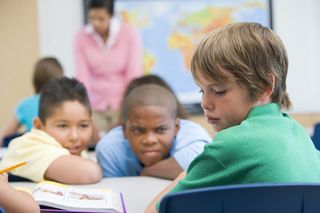'Empathy Gap': Why Some Can't See Bully Victims' Pain

Unless they've experienced it firsthand, people underestimate the social pain endured by victims of bullying, a new study finds.
This so-called "empathy gap" can be devastating, the researchers say, because it means victims often don't get the support they need. For instance, a teacher who doesn't truly "get" the suffering involved in being teased or excluded would be less likely to punish the perpetrator or give support to the victim.
"Everyone knows that social trauma is unpleasant, but people are often blind to the full severity of these experiences and therefore don't do enough to protect or intervene when victims suffer," said lead researcher Loran Nordgren, assistant professor of management and organizations at the Kellogg School of Management at Northwestern University in Illinois.
Bully victims suffer
Nordgren points out recent news stories of victims of bullies who took their own lives due to harassment at school or online through social networks. For instance, last January 15-year-old Phoebe Prince hanged herself after enduring months of teasing from schoolmates in a Massachusetts high school. Parents, teachers and friends are often caught off guard by the extreme reactions, such as suicide, he noted. If these outsiders really understood the pain of being bullied, "I think they would've done more to both comfort the victim and [have] tried to intervene," Nordgren told LiveScience.
In fact, some 25 percent of public schools have reported bullying among students on a daily or weekly basis, with 43 percent of students saying they've experienced some form of cyberbullying, according to Nordgren.
"As a parent your kid comes home and says 'Kids were picking on me at school.' You know that is a difficult experience for your child, but you're not understanding the true severity of the pain your child is going through," Nordgren said.
Sign up for the Live Science daily newsletter now
Get the world’s most fascinating discoveries delivered straight to your inbox.
And bullies aren't unique to schools, as the same thing happens at work, and so the results also apply to how workplaces deal with the victims. In addition, social pain occurs after the death of a loved one, and so having empathy in this realm could change workplace policies for time off and other means of support for bereavement.
"While educators and policy makers have developed programs and laws to prevent incidents of bullying, our research suggests this may not be enough," Nordgren said, adding that teachers and administrators should complete training that simulates socially painful events like bullying to close this empathy gap.
Understanding the pain
In the study, Nordgren and his colleagues had participants play an online ball-tossing game, in which they were supposedly throwing the ball with two other players, who were actually just part of a computer program. Some participants received the ball a fair one-third of the time (called the inclusion condition), while others got tossed the ball 10 percent of the time (exclusion condition). Another group of students, the control group, didn't play the game at all.
Then students estimated how they would feel if they experienced each of five events, two of which involved social exclusion:
- Learning your close friends did not invite you to their party
- Asking someone out on a date and getting turned down
- Getting a bad grade on a test
- Finding a spider in your bed
- Discovering someone stole your wallet
Ratings were based on an 11-point scale, each point represented by a facial expression showing an increasing magnitude of pain. Those excluded students indicated a significantly higher pain experience linked to the two social-exclusion scenarios compared with the inclusion group (4.6 versus 3.7). For the other scenarios, the pain ratings didn't differ between the groups.
Three other experiments using the cyberball game, with various tweaks, showed similar results. In one, the players had to indicate how a victim of bullying (named Anna) felt after "Roger" teased her, shouting "earthquake" when she passed by due to her being overweight. The exclusion students rated her pain an average of 5.5 versus 4.3 rating from the inclusion group.
Empathetic teachers needed
In a fifth experiment, the researchers had middle-school teachers play the cyberball game and then read the "Anna" scenario. In addition to rating how Anna felt, teachers had to indicate the level of punishment Roger should receive for bullying Anna, with levels ranging from one (no punishment) to seven (the school's maximum punishment).
Not only did the "excluded teachers" rate Anna's pain as higher, they also indicated a higher level of punishment, an average of 4.8 compared with the 3.8 given by included teachers.
"All told, our perception of social pain matters as much as our understanding of physical pain. Not only do estimates of social pain govern how we empathize with socially traumatic events, but they guide our approach to how well we advocate on a victim's behalf," he said.
The findings are detailed in the current issue of Journal of Personality and Social Psychology.
You can follow LiveScience Managing Editor Jeanna Bryner on Twitter @jeannabryner.

Jeanna served as editor-in-chief of Live Science. Previously, she was an assistant editor at Scholastic's Science World magazine. Jeanna has an English degree from Salisbury University, a master's degree in biogeochemistry and environmental sciences from the University of Maryland, and a graduate science journalism degree from New York University. She has worked as a biologist in Florida, where she monitored wetlands and did field surveys for endangered species. She also received an ocean sciences journalism fellowship from Woods Hole Oceanographic Institution.
Most Popular


